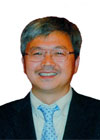

Physical chemist, was born in Deqing, Zhejiang Province on Oct. 11, 1962. He received his Ph. D. in chemistry from University of California at Santa Barbara in 1991. After postdoctoral experiences in Princeton University and University of California at Berkeley from 1991 to 1995, he became an associated research fellow in the Institute of Atomic and Molecular Sciences in Taipei at the end of 1995, and was promoted to a full research fellow with tenure in 2000. In 2001, he made a move to Dalian Institute of Chemical Physics, Chinese Academy of Sciences, and become a research professor and director of the State Key Laboratory of Molecular Reaction Dynamics.
His main research interests are in the area of experimental chemical dynamics and spectroscopy in the gas phase and at the interfaces. He has developed a new generation of crossed molecular beam instruments, and applied them to study important problems in chemical reaction dynamics. He has published about 200 scientific papers, including 7 in Science and 1 in Nature.
State-to-state Chemical Reaction Dynamics
Abstract
During the last decade or so, Dr. Yang has used advanced molecular beam instruments developed in his own laboratory and studied the state-to-state dynamics of a number of important elementary chemical reactions. He and his colleagues investigated the F+H2 reaction and developed an accurate physical picture of reaction resonances in this important system in a series of combined experimental and theoretical works. In addition, he has also studied the state-to-state non-adiabatic dynamics of the F+D2 reaction and observed the breakdown of Born-Oppenheimer approximation in this reaction. These research works have made significant impacts in deepening our understanding of chemical reaction resonances and chemical non-adiabaticity at the quantum state-to-state level.